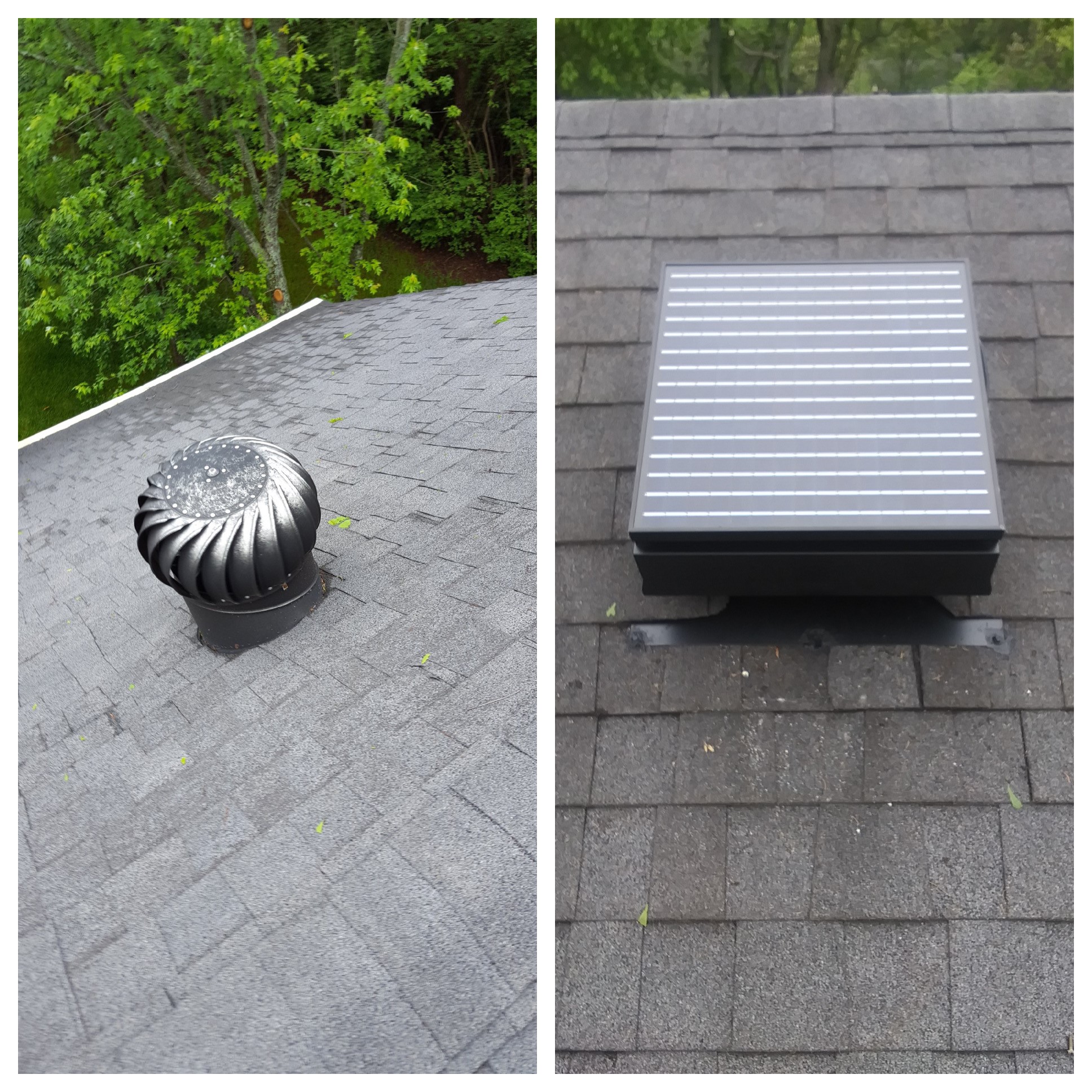Understanding Attic Ventilation Fans

Every home with an unconditioned attic needs ventilation so that the insulation can keep the house cool. Most homes are fitted with rooftop vents to allow the flow of air. In the DFW area, we commonly see ridge vents built into the roof, air hawks, whirlybirds, and powered fans. Other than the fans, the other types of vents are all passive. The fans installed in roof vents usually fall into two categories – 1) Passive and 2) Powered.
Passive vs Powered Ventilation
Passive vents just spin freely as air moves through them. These vents are dependent on the natural airflow, and on a calm, hot afternoon they may not properly ventilate your attic. The air here in Dallas and Colin counties can be extremely heavy and static. A cool breeze flowing up from south of Dallas is welcomed but rare during the summer. The static vents rely on heat rising and flowing through them voluntarily. The issue we see a lot around DFW, especially in older houses, is that our roof pitches are not high enough to create a steady draw. The idea is like that of a fireplace, but in that instance, you need about 15-16 feet from where the logs are placed to the peak of the chimney to create enough of a draw to effectively pull the smoke up and out. It’s pretty rare in Dallas and Richardson, especially in older homes, to have this kind of attic height. We see more 5-10 foot attic ridges that not. At these heights, the static vents don’t create enough air turnover. Powered fans turn themselves to promote the movement of fresh air through the attic, keeping it cool no matter the outdoor conditions.
Two Types of Powered Vents
Powered fans can be broken down further into two groups: electrical, and solar. Many homes use traditional electrical fans, but they are expensive to install and run. That’s why Koala Insulation of Nashville uses Solar Ventilation Fans. Solar Powered Fans are more cost-effective than electrical fans. Here’s why:
- Once the Solar Fan is installed, it costs nothing to run, unlike electrical fans which are plugged in and run on your home’s power. One of our customers in Richardson is an electrical engineer. He called us looking specifically to swap out his two electric fans for our solar powered models. He told us that he had done the calculations and figured that his electric fans were costing him roughly $15 per month to run.
- Electric fans typically have motors rated at 5,000 hours versus our solar fans rated for 90,000 hours, which should last 40 years.
- Electric fans have metal blades that fail regularly. Once a blade is bent the fan’s lifespan is quickly ticking away. Our fans have one-piece die cast blade. It does not warp or bend.
- Having a Solar Fan actually saves energy by making it easier for you’re A/C to do its job.
- You will qualify for a tax credit for using renewable energy. Contact us for more information on how much you can save. https://koalainsulation.com/dallas
- Even better, our solar fans have a lifetime warranty from the manufacturer — a company in Houston that stands firmly behind its product
Our aim is to lower your attic temperature. This takes the pressure off the insulation as well as your HVAC unit, shingles, and ductwork. We can achieve this by getting 10 full air exchanges per hour. When we come to your house we calculate the total cubic feet of air your attic holds. We factor in other things such as the color of your shingles, your roof’s configuration, and the amount of air intake available to determine how many cubic feet per minute (CFM) we need to move to reach that number of air exchanges.
It’s very important that your attic stays at a reasonable temperature, and Solar Ventilation Fans provide the ventilation you need on a hot day. Passive ventilation won’t stand a chance against the afternoon sun, and electrical fans will cost you more than you want to pay. While an Electrically Powered Fan will cost you thousands over the span of years, the Solar Powered Fan will cost nothing more than its initial installation cost. Keeping that air moving also reduces the chance of mold and mildew developing in your attic.
Already have an electric fan, whirlybird, or air hawk that is ineffective? We can swap them out and use the same opening in your roof without further intrusions! We will even haul the old one away and dispose of it for you.
Contact Koala Insulation of Dallas to learn more about ventilation and having a healthy attic. Visit Koala Insulation of Dallas to see what we can do for your home.
Find Your Location


Get a quote


